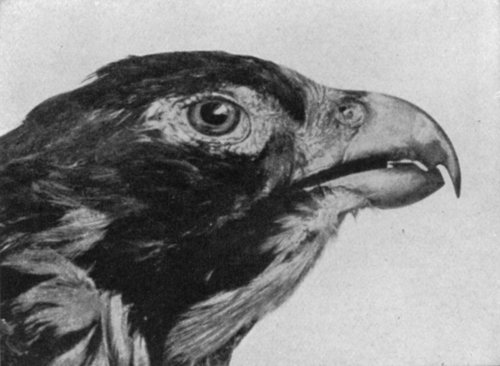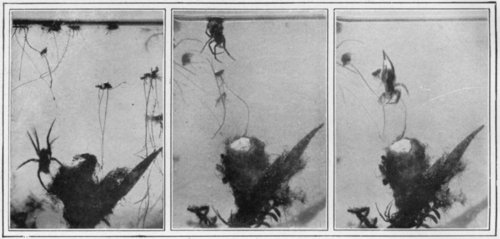EVOLUTION GOING ON
Evolution, as we have seen in a previous chapter, is another word for race-history. It means the ceaseless process of Becoming, linking generation to generation of living creatures. The Doctrine of Evolution states the fact that the present is the child of the past and the parent of the future. It comes to this, that the living plants and animals we know are descended from ancestors on the whole simpler, and these from others likewise simpler, and so on, back and back—till we reach the first living creatures, of which, unfortunately, we know nothing. Evolution is a process of racial change in a definite direction, whereby new forms arise, take root, and flourish, alongside of or in the place of their ancestors, which were in most cases rather simpler in structure and behaviour.
The rock-record, which cannot be wrong, though we may read it wrongly, shows clearly that there was once a time in the history of the Earth when the only backboned animals were Fishes. Ages passed, and there evolved Amphibians, with fingers and toes, scrambling on to dry land. Ages passed, and there evolved Reptiles, in bewildering profusion. There were fish-lizards and sea-serpents, terrestrial dragons and flying dragons, a prolific and varied stock. From the terrestrial Dinosaurs it seems that Birds and Mammals arose. In succeeding ages there evolved all the variety of Birds and all the variety of Mammals. Until at last arose the Man. The question is whether similar processes of evolution are still going on.
We are so keenly aware of rapid changes in mankind, though[Pg 186] these concern the social heritage much more than the flesh-and-blood natural inheritance, that we find no difficulty in the idea that evolution is going on in mankind. We know the contrast between modern man and primitive man, and we are convinced that in the past, at least, progress has been a reality. That degeneration may set in is an awful possibility—involution rather than evolution—but even if going back became for a time the rule, we cannot give up the hope that the race would recover itself and begin afresh to go forward. For although there have been retrogressions in the history of life, continued through unthinkably long ages, and although great races, the Flying Dragons for instance, have become utterly extinct, leaving no successors whatsoever, we feel sure that there has been on the whole a progress towards nobler, more masterful, more emancipated, more intelligent, and better forms of life—a progress towards what mankind at its best has always regarded as best, i.e. affording most enduring satisfaction. So we think of evolution going on in mankind, evolution chequered by involution, but on the whole progressive evolution.
Evolutionary Prospect for Man
It is not likely that man's body will admit of great change, but there is room for some improvement, e.g. in the superfluous length of the food-canal and the overcrowding of the teeth. It is likely, however, that there will be constitutional changes, e.g. of prolonged youthfulness, a higher standard of healthfulness, and a greater resistance to disease. It is justifiable to look forward to great improvements in intelligence and in control. The potentialities of the human brain, as it is, are far from being utilised to the full, and new departures of promise are of continual occurrence. What is of great importance is that the new departures or variations which emerge in fine children should be fostered, not nipped in the bud, by the social environment, education included. The evolutionary prospect for man is promising.
PHOTOGRAPH OF A MEDIAN SECTION THROUGH THE SHELL OF THE PEARLY NAUTILUS
It is only the large terminal chamber that is occupied by the animal.
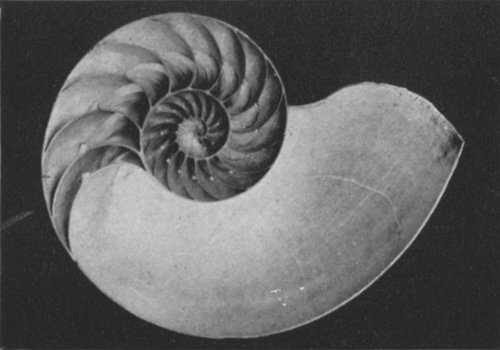
PHOTOGRAPH OF THE ENTIRE SHELL OF THE PEARLY NAUTILUS
The headquarters of the Nautilus are in the Indian and Pacific Oceans. They sometimes swim at the surface of the sea, but they usually creep slowly about on the floor of comparatively shallow water.
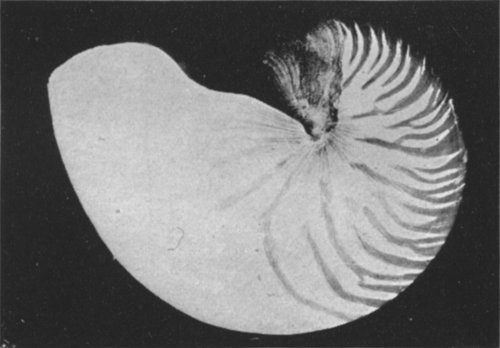
NAUTILUS
A section through the Pearly Nautilus, Nautilus pompilius, common from Malay to Fiji. The shell is often about 9 inches long. The animal lives in the last chamber only, but a tube (S) runs through the empty chambers, perforating the partitions (SE). The bulk of the animal is marked VM; the eye is shown at E; a hood is marked H; round the mouth there are numerous lobes (L) bearing protrusible tentacles, some of which are shown. When the animal is swimming near the surface the tentacles radiate out in all directions, and it has been described as "a shell with something like a cauliflower sticking out of it." The Pearly Nautilus is a good example of a conservative type, for it began in the Triassic Era. But the family of Nautiloids to which it belongs illustrates very vividly what is meant by a dwindling race. The Nautiloids began in the Cambrian, reached their golden age in the Silurian, and began to decline markedly in the Carboniferous. There are 2,500 extinct or fossil species of Nautiloids, and only 4 living to-day.
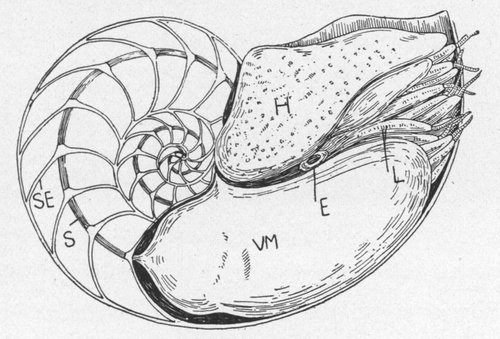
Photo: W. S. Berridge.
SHOEBILL
A bird of a savage nature, never mixing with other marsh birds. According to Dr. Chalmers Mitchell, it shows affinities to herons, storks, pelicans, and gannets, and is a representative of a type equal to both herons and storks and falling between the two.
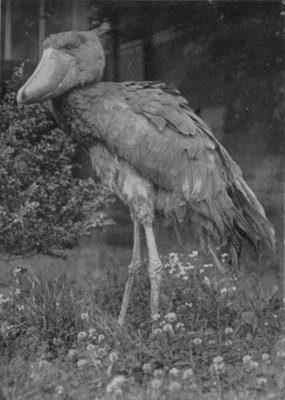
[Pg 187]
But it is very important to realise that among plant and animals likewise, Evolution is going on.
The Fountain of Change: Variability
On an ordinary big clock we do not readily see that even the minute hand is moving, and if the clock struck only once in a hundred years we can conceive of people arguing whether the hands did really move at all. So it often is with the changes that go on from generation to generation in living creatures. The flux is so slow, like the flowing of a glacier, that some people fail to be convinced of its reality. And it must, of course, be admitted that some kinds of living creatures, like the Lamp-shell Ligula or the Pearly Nautilus, hardly change from age to age, whereas others, like some of the birds and butterflies, are always giving rise to something new. The Evening Primrose among plants, and the Fruit-fly, Drosophila, among animals, are well-known examples of organisms which are at present in a sporting or mutating mood.
Certain dark varieties of moth, e.g. of the Peppered Moth, are taking the place of the paler type in some parts of England, and the same is true of some dark forms of Sugar-bird in the West Indian islands. Very important is the piece of statistics worked out by Professor R. C. Punnett, that "if a population contains .001 per cent of a new variety, and if that variety has even a 5 per cent selection advantage over the original form, the latter will almost completely disappear in less than a hundred generations." This sort of thing has been going on all over the world for untold ages, and the face of animate nature has consequently changed.
We are impressed by striking novelties that crop up—a clever dwarf, a musical genius, a calculating boy, a cock with a 10 ft. tail, a "wonder-horse" with a mane reaching to the ground, a tailless cat, a white blackbird, a copper beech, a Greater Celandine with much cut up leaves; but this sort of mutation is common, and smaller, less brusque variations are commoner still. They form the raw materials of possible evolution. We are[Pg 188] actually standing before an apparently inexhaustible fountain of change. This is evolution going on.
The Sporting Jellyfish
It is of interest to consider a common animal like the jellyfish Aurelia. It is admirably suited for a leisurely life in the open sea, where it swims about by contracting its saucer-shaped body, thus driving water out from its concavity. By means of millions of stinging cells on its four frilled lips and on its marginal tentacles it is able to paralyse and lasso minute crustaceans and the like, which it then wafts into its mouth. It has a very eventful life-history, for it has in its early youth to pass through a fixed stage, fastened to rock or seaweed, but it is a successful animal, well suited for its habitat, and practically cosmopolitan in its distribution. It is certainly an old-established creature. Yet it is very variable in colour and in size, and even in internal structure. Very often it is the size of a saucer or a soup-plate, but giants over two feet in diameter are well known. Much more important, however, than variation in colour and size are the inborn changes in structure. Normally a jellyfish has its parts in four or multiples of four. Thus it has four frilled lips, four tufts of digestive filaments in its stomach, and four brightly coloured reproductive organs. It has eight sense-organs round the margin of its disc, eight branched and eight unbranched radial canals running from the central stomach to a canal round the circumference. The point of giving these details is just this, that every now and then we find a jellyfish with its parts in sixes, fives, or threes, and with a multitude of minor idiosyncrasies. Even in the well-established jellyfish there is a fountain of change.
§ 1
Evolution of Plants
It is instructive to look at the various kinds of cabbages, such as cauliflower and Brussels sprouts, kale and curly greens, and[Pg 189] remember that they are all scions of the not very promising wild cabbage found on our shores. And are not all the aristocrat apple-trees of our orchards descended from the plebeian crab-apple of the roadside? We know far too little about the precise origin of our cultivated plants, but there is no doubt that after man got a hold of them he took advantage of their variability to establish race after race, say, of rose and chrysanthemum, of potato and cereal. The evolution of cultivated plants is continuing before our eyes, and the creations of Mr. Luther Burbank, such as the stoneless plum and the primus berry, the spineless cactus and the Shasta daisy, are merely striking instances of what is always going on.
There is reason to believe that the domestic dog has risen three times, from three distinct ancestors—a wolf, a jackal, and a coyote. So a multiple pedigree must be allowed for in the case of the dog, and the same is true in regard to some other domesticated animals. But the big fact is the great variety of breeds that man has been able to fix, after he once got started with a domesticated type. There are over 200 well-marked breeds of domestic pigeons, and there is very strong evidence that all are descended from the wild rock-dove, just as the numerous kinds of poultry are descended from the jungle-fowl of some parts of India and the Malay Islands. Even more familiar is the way in which man has, so to speak, unpacked the complex fur of the wild rabbit, and established all the numerous colour-varieties which we see among domestic rabbits. And apart from colour-varieties there are long-haired Angoras and quaint lop-eared forms, and many more besides. All this points to evolution going on.
The Romance of the Wheat
It is well-known that Neolithic man grew wheat, and some authorities have put the date of the first wheat harvest at between fifteen thousand and ten thousand years ago. The ancient civilisations[Pg 190] of Babylonia, Egypt, Crete, Greece, and Rome were largely based on wheat, and it is highly probable that the first great wheatfields were in the fertile land between the Tigris and the Euphrates. The oldest Egyptian tombs that contain wheat, which, by the way, never germinates after its millennia of rest, belong to the First Dynasty, and are about six thousand years old. But there must have been a long history of wheat before that.
Now it is a very interesting fact that the almost certain ancestor of the cultivated wheat is at present living on the arid and rocky slopes of Mount Hermon. It is called Triticum hermonis, and it is varying notably to-day, as it did long ago when it gave rise to the emmer, which was cultivated in the Neolithic Age and is the ancestor of all our ordinary wheats. We must think of Neolithic man noticing the big seeds of this Hermon grass, gathering some of the heads, breaking the brittle spikelet-bearing axis in his fingers, knocking off the rough awns or bruising the spikelets in his hand till the glumes or chaff separated off and could be blown away, chewing a mouthful of the seeds—and resolving to sow and sow again.
That was the beginning of a long story, in the course of which man took advantage of the numerous variations that cropped up in this sporting stock and established one successful race after another on his fields. Virgil refers in the "Georgics" to the gathering of the largest and fullest ears of wheat in order to get good seed for another sowing, but it was not till the first quarter of the nineteenth century that the great step was taken, by men like Patrick Sheriff of Haddington, of deliberately selecting individual ears of great excellence and segregating their progeny from mingling with mediocre stock. This is the method which has been followed with remarkable success in modern times.
One of the factors that assisted the Allies in overcoming the food crisis in the darkest period of the war was the virtue of Marquis Wheat, a very prolific, early ripening, hard red spring wheat[Pg 191] with excellent milling and baking qualities. It is now the dominant spring wheat in Canada and the United States, and it has enormously increased the real wealth of the world in the last ten years (1921). Now our point is simply that this Marquis Wheat is a fine example of evolution going on. In 1917 upwards of 250,000,000 bushels of this wheat were raised in North America, and in 1918 upwards of 300,000,000 bushels; yet the whole originated from a single grain planted in an experimental plot at Ottawa by Dr. Charles E. Saunders so recently as the spring of 1903.
THE WALKING-FISH OR MUD-SKIPPER (PERIOPHTHALMUS), COMMON AT THE MOUTHS OF RIVERS IN TROPICAL AFRICA, ASIA, AND NORTH-WEST AUSTRALIA
It skips about by means of its strong pectoral fins on the mud-flats; it jumps from stone to stone hunting small shore-animals; it climbs up the roots of the mangrove-trees. The close-set eyes protrude greatly and are very mobile. The tail seems to help in respiration.
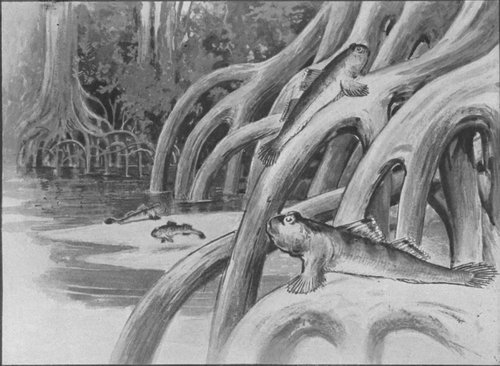
Photo: "The Times."
THE AUSTRALIAN MORE-PORK OR PODARGUS
A bird with a frog-like mouth, allied to the British Nightjar. Now in the London Zoological Gardens.
The capacious mouth is well suited for engulfing large insects such as locusts and mantises, which are mostly caught on the trees. During the day the More-pork or Frog-mouth sleeps upright on a branch, and its mottled brown plumage makes it almost invisible.
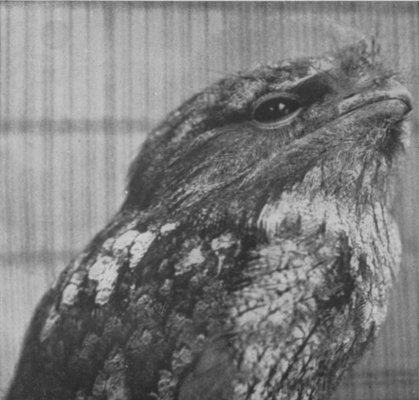
PELICAN'S BILL, ADAPTED FOR CATCHING AND STORING FISHES
There is an enormous dilatable sac beneath the lower jaw.
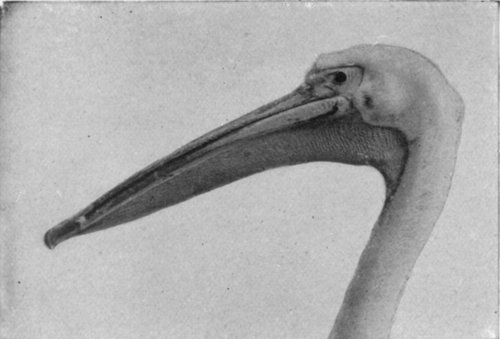
SPOONBILL'S BILL, ADAPTED FOR SIFTING THE MUD AND CATCHING THE SMALL ANIMALS, E.G. FISHES, CRUSTACEANS, INSECT LARVÆ, WHICH LIVE THERE
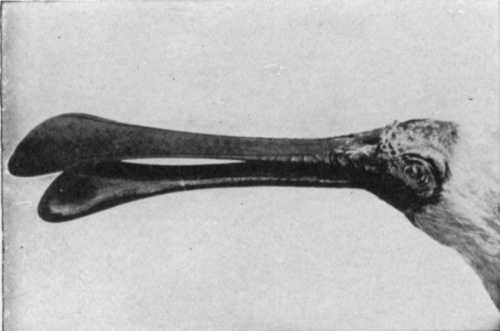
AVOCET'S BILL, ADAPTED FOR A CURIOUS SIDEWAYS SCOOPING IN THE SHORE-POOLS AND CATCHING SMALL ANIMALS
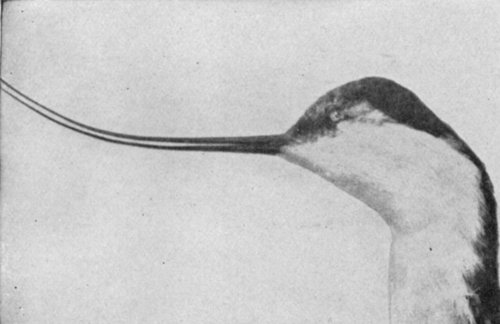
HORNBILL'S BILL, ADAPTED FOR EXCAVATING A NEST IN A TREE, AND ALSO FOR SEIZING AND BREAKING DIVERSE FORMS OF FOOD, FROM MAMMALS TO TORTOISES, FROM ROOTS TO FRUITS
The use of the helmet or casque is obscure.
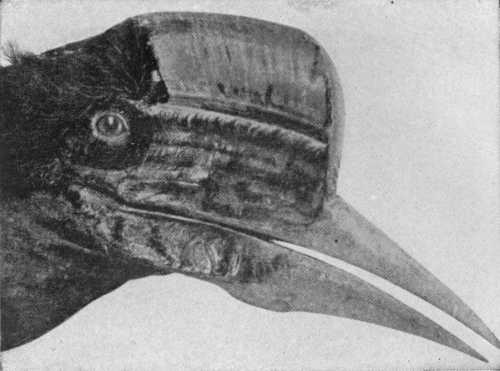
PUFFIN'S BILL, ADAPTED FOR CATCHING SMALL FISHES NEAR THE SURFACE OF THE SEA, AND FOR HOLDING THEM WHEN CAUGHT AND CARRYING THEM TO THE NEST
The scaly covering is moulted in the autumn.
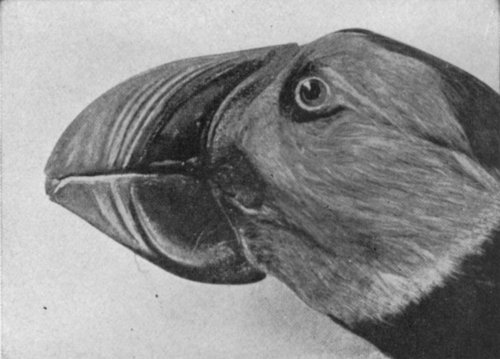
We must not dwell too long on this particular instance of evolution, though it has meant much to our race. We wish, however, following Professor Buller's Essays on Wheat (1919), to explain the method by which this good seed was discovered. From one we may learn all. The parent of Marquis Wheat on the male side was the mid-Europe Red Fife—a first-class cereal. The parent on the female side was less promising, a rather nondescript, not pure-bred wheat, called Red Calcutta, which was imported from India into Canada about thirty years ago. The father was part of a cargo that came from the Baltic to Glasgow, and was happily included in a sample sent on to David Fife in Ontario about 1842. From one kernel of this sample David Fife started his stock of Red Fife, which was crossed by Dr. Saunders with Hard Red Calcutta. The result of the cross was a medley of types, nearly a hundred varieties altogether, and it was in scrutinising these that Dr. Saunders hit upon Marquis. He worked steadily through the material, studying head after head of what resulted from sowing, and selecting out those that gave most promise. Each of the heads selected was propagated; most of the results were rejected; the elect were sifted again and yet again, and finally Marquis Wheat emerged, rich in constructive possibilities, probably the most valuable food-plant in the world. It is like a romance to read that "the first crop of the wheat that was destined within a dozen years to overtax the mightiest elevators[Pg 192] in the land was stored away in the winter of 1904-5 in a paper packet no larger than an envelope."
Thus from the Wild Wheat of Mount Hermon there evolved one of the most important food-plants of the world. This surely is Evolution going on.
§ 2
Changes in the Animal Life of a Country
Nothing gives us a more convincing impression of evolution in being than a succession of pictures of the animal life of a country in different ages. Dr. James Ritchie, a naturalist of distinction, has written a masterly book, The Influence of Man on Animal Life in Scotland (1920), in which we get this succession of pictures. "Within itself," he says, "a fauna is in a constant state of uneasy restlessness, an assemblage of creatures which in its parts ebbs and flows as one local influence or another plays upon it." There are temporary and local changes, endless disturbances and readjustments of the "balance of nature." One year there is a plague of field-voles, perhaps next year "grouse disease" is rife; in one place there is huge increase of starlings, in another place of rabbits; here cockchafers are in the ascendant, and there the moles are spoiling the pasture. "But while the parts fluctuate, the fauna as a whole follows a path of its own. As well as internal tides which swing to and fro about an average level, there is a drift which carries the fauna bodily along an 'irretraceable course.'" This is partly due to considerable changes of climate, for climate calls the tune to which living creatures dance, but it is also due to new departures among the animals themselves. We need not go back to the extinct animals and lost faunas of past ages—for Britain has plenty of relics of these—which "illustrate the reality of the faunal drift," but it may be very useful, in illustration of evolution in being, to notice what has happened in Scotland since the end of the Great Ice Age.
Some nine thousand years ago or more, certain long-headed,[Pg 193] square-jawed, short-limbed, but agile hunters and fishermen, whom we call Neolithic Man, established themselves in Scotland. What was the state of the country then?
It was a country of swamps, low forests of birch, alder, and willow, fertile meadows, and snow-capped mountains. Its estuaries penetrated further inland than they now do, and the sea stood at the level of the Fifty-Foot Beach. On its plains and in its forests roamed many creatures which are strange to the fauna of to-day—the Elk and the Reindeer, Wild Cattle, the Wild Boar and perhaps Wild Horses, a fauna of large animals which paid toll to the European Lynx, the Brown Bear and the Wolf. In all likelihood, the marshes resounded to the boom of the Bittern and the plains to the breeding calls of the Crane and the Great Bustard.
Such is Dr. Ritchie's initial picture.
LIFE-HISTORY OF A FROG
1, Before hatching; 2, newly hatched larvæ hanging on to water-weed; 3, with external gills; 4, external gills are covered over and are absorbed; 5, limbless larva about a month old with internal gills; 6, tadpole with hind-legs, about two months old; 7, with the fore-limbs emerging; 8, with all four legs free; 9, a young frog, about three months old, showing the almost complete absorption of the tail and the change of the tadpole mouth into a frog mouth.
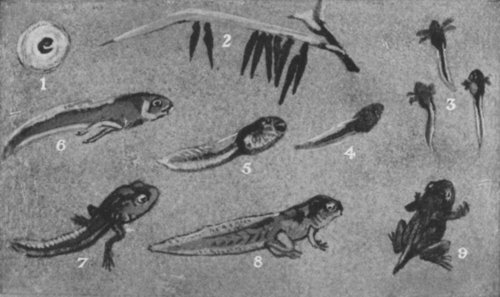
Photo: J. J. Ward. F.E.S.
HIND-LEG OF WHIRLIGIG BEETLE WHICH HAS BECOME BEAUTIFULLY MODIFIED FOR AQUATIC LOCOMOTION
The flattened tips form an expanding "fan" or paddle, which opens and closes with astonishing rapidity. The closing of the "fan," like the "feathering" of an oar, reduces friction when the leg is being moved forwards for the next stroke.
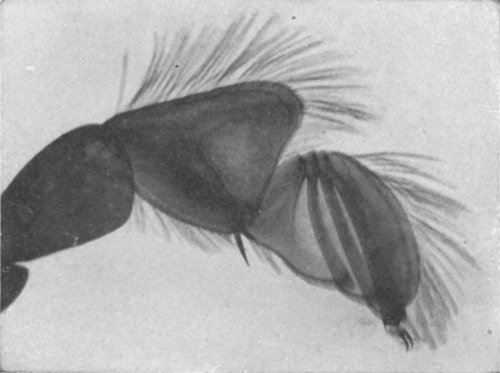
THE BIG ROBBER-CRAB (Birgus Latro), THAT CLIMBS THE COCO-NUT PALM AND BREAKS OFF THE NUTS
It occurs on islands in the Indian Ocean and Pacific, and is often found far above sea-level. It is able to breathe dry air. One is seen emerging from its burrow, which is often lined with coco-nut fibre. The empty coco-nut shell is sometimes used by the Robber-Crab for the protection of its tail.
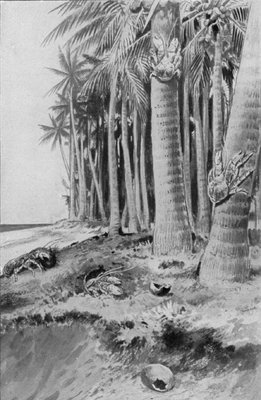
Now what happened in this kingdom of Caledonia which Neolithic Man had found? He began to introduce domesticated animals, and that meant a thinning of the ranks of predacious creatures. "Safety first" was the dangerous motto in obedience to which man exterminated the lynx, the brown bear, and the wolf. Other creatures, such as the great auk, were destroyed for food, and others like the marten for their furs. Small pests were destroyed to protect the beginnings of agriculture; larger animals like the boar were hunted out of existence; others, like the pearl-bearing river-mussels, yielded to subtler demands. No doubt there was protection also—protection for sport, for utility, for æsthetic reasons, and because of humane sentiments; even wholesome superstitions have safeguarded the robin redbreast and the wren. There were introductions too—the rabbit for utility, the pheasant for sport, and the peacock for amenity. And every introduction, every protection, every killing out had its far-reaching influences.
But if we are to picture the evolution going on, we must think also of man's indirect interference with animal life. He destroyed[Pg 194] the forests, he cultivated the wild, he made bridges, he allowed aliens, like rats and cockroaches, to get in unawares. Of course, he often did good, as when he drained swamps and got rid of the mosquitoes which once made malaria rife in Scotland.
What has been the net result? Not, as one might think for a moment, a reduction in the number of different kinds of animals. Fourteen or so species of birds and beasts have been banished from Scotland since man interfered, but as far as numbers go they have been more than replaced by deliberate introductions like fallow deer, rabbit, squirrel, and pheasant, and by accidental introductions like rats and cockroaches. But the change is rather in quality than in quantity; the smaller have taken the place of the larger, rather paltry pigmies of noble giants. Thus we get a vivid idea that evolution, especially when man interferes, is not necessarily progressive. That depends on the nature of the sieves with which the living materials are sifted. As Dr. Ritchie well says, the standard of the wild fauna as regards size has fallen and is falling, and it is not in size only that there is loss, there is a deterioration of quality. "For how can the increase of Rabbits and Sparrows and Earthworms and Caterpillars, and the addition of millions of Rats and Cochroaches and Crickets and Bugs, ever take the place of those fine creatures round the memories of which the glamour of Scotland's past still plays—the Reindeer and the Elk, the Wolf, the Brown Bear, the Lynx, and the Beaver, the Bustard, the Crane, the Bumbling Bittern, and many another, lost or disappearing." Thus we see again that evolution is going on.
§ 3
The Adventurers
All through the millions of years during which animals have tenanted the earth and the waters under the earth, there has been a search for new kingdoms to conquer, for new corners in which to make a home. And this still goes on. It has been and[Pg 195] is one of the methods of evolution to fill every niche of opportunity. There is a spider that lives inside a pitcher-plant, catching some of the inquisitive insects which slip down the treacherous internal surface of the trap. There is another that makes its home in crevices among the rocks on the shore of the Mediterranean, or even in empty tubular shells, keeping the water out, more or less successfully, by spinning threads of silk across the entrance to its retreat. The beautiful brine-shrimp, Artemia salina, that used to occur in British salterns has found a home in the dense waters of the Great Salt Lake of Utah. Several kinds of earthworms have been found up trees, and there is a fish, Arges, that climbs on the stones of steep mountain torrents of the Andes. The intrepid explorers of the Scotia voyage found quite a number of Arctic terns spending our winter within the summer of the Antarctic Circle—which means girdling the globe from pole to pole; and every now and then there are incursions of rare birds, like Pallas's Sand-grouse, into Britain, just as if they were prospecting in search of a promised land. Twice or thrice the distinctively North American Killdeer Plover has been found in Britain, having somehow or other got across the Atlantic. We miss part of the meaning of evolution if we do not catch this note of insurgence and adventure, which some animal or other never ceases to sound, though many establish themselves in a security not easily disturbed, and though a small minority give up the struggle against the stream and are content to acquiesce, as parasites or rottenness eaters, in a drifting life of ease.
More important than very peculiar cases is the broad fact that over and over again in different groups of animals there have been attempts to master different kinds of haunts—such as the underground world, the trees, the freshwaters, and the air. There are burrowing amphibians, burrowing reptiles, burrowing birds, and burrowing mammals; there are tree-toads, tree-snakes, tree-lizards, tree-kangaroos, tree-sloths, tree-shrews, tree-mice, tree-porcupines, and so on; enough of a list to show, without[Pg 196] mentioning birds, how many different kinds of animals have entered upon an arboreal apprenticeship—an apprenticeship often with far-reaching consequences. What the freeing of the hand from being an organ of terrestrial support has meant in the evolution of monkeys is a question that gives a spur to our imagination.
The Case of the Robber Crab
On some of the coral islands of the Indian and Pacific Oceans there lives a land-crab, Birgus, which has learned to breathe on land. It breathes dry air by means of curious blood-containing tufts in the upper part of its gill-cavity, and it has also rudimentary gills. It is often about a foot long, and it has very heavy great claws, especially on the left-hand side. With this great claw it hammers on the "eye-hole" of a coconut, from which it has torn off the fibrous husk. It hammers until a hole is made by which it can get at the pulp. Part of the shell is sometimes used as a protection for the soft abdomen—for the robber-crab, as it is called, is an offshoot from the hermit-crab stock. Every year this quaint explorer, which may go far up the hills and climb the coco-palms, has to go back to the sea to spawn. The young ones are hatched in the same state as in our common shore-crab. That is to say, they are free-swimming larvæ which pass through an open-water period before they settle down on the shore, and eventually creep up on to dry land. Just as open-water turtles lay their eggs on sandy shores, going back to their old terrestrial haunt, so the robber-crab, which has almost conquered the dry land, has to return to the seashore to breed. There is a peculiar interest in the association of the robber-crab with the coco-palm, for that tree is not a native of these coral islands, but has been introduced, perhaps from Mexico, by the Polynesian mariners before the discovery of America by Columbus. So the learning to deal with coconuts is a recent achievement, and we are face to face with a very good example of evolution going on.
EARLY LIFE-HISTORY OF THE SALMON
1. The fertilised egg, shed in the gravelly bed of the river.
2. The embryo within the egg, just before hatching. The embryo has been constricted off from the yolk-laden portion of the egg.
3. The newly hatched salmon, or alevin, encumbered with its legacy of yolk (Y.S.).
4 and 5. The larval salmon, still being nourished from the yolk-sac (Y.S.), which is diminishing in size as the fish grows larger.
6. The salmon fry about six weeks old, with the yolk fully absorbed, so that the young fish has now to feed for itself. The fry become parr, which go to the sea as smolts, and return as grilse.
In all cases the small figures to the right indicate the natural size.
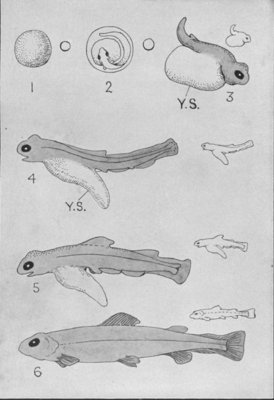
THE SALMON LEAPING AT THE FALL IS A MOST FASCINATING SPECTACLE
Again and again we see them jumping out of the seething foam beneath the fall, casting themselves into the curtain of the down-rushing water, only to be carried back by it into the depths whence they have risen. One here and another there makes its effort good, touches the upper lip of the cataract, gives a swift stroke of its tail, and rushes on towards those upper reaches which are the immemorial spawning beds of its race.
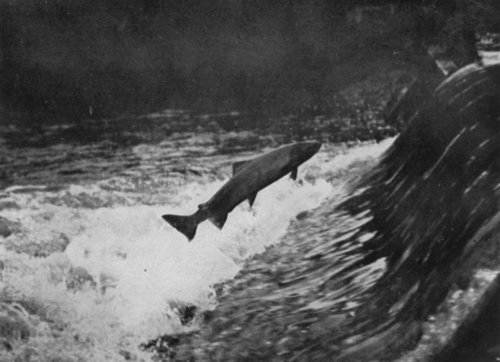
[Pg 197]
The Story of the Salmon
In late autumn or in winter the salmon spawn in the rivers. The female makes a shallow trough in the gravel by moving her tail from side to side, and therein lays many eggs. The male, who is in attendance, fertilises these with the milt, and then the female covers them deeply with gravel. The process is repeated over and over again for a week or more till all the eggs are shed. For three to four months the eggs develop, and eventually there emerge the larvæ or alevins, which lurk among the pebbles. They cannot swim much, for they are encumbered by a big legacy of yolk. In a few weeks, perhaps eight, the protruding bag of yolk has disappeared and the fry, about an inch long, begin to move about more actively and to fend for themselves. By the end of the year they have grown to be rather trout-like parr, about four inches long. In two years these are double that length. Usually in the second year, but it may be earlier or later, the parr become silvery smolts, which go out to sea, usually about the month of May. They feed on young herring and the like and grow large and strong. When they are about three and a half years old they come up the rivers as grilse and may spawn. Or they may pass through the whole grilse stage in the sea and come up the rivers with all the characters of the full-grown fish. In many cases the salmon spawn only once, and some (they are called kelts after spawning) are so much exhausted by starting a new generation that they die or fall a victim to otters and other enemies. In the case of the salmon of the North Pacific (in the genus Oncorhynchus, not Salmo) all the individuals die after spawning, none being able to return to the sea. It must be remembered that full-grown salmon do not as a rule feed in fresh water, though they may be unable to resist snapping at the angler's strange creations. A very interesting fact is that the salmon keeps as it were a diary of its movements, which vary a good deal in different rivers. This diary is written in the scales, and a careful reading of the concentric lines on the scales shows the age of the fish, and[Pg 198] when it went out to sea, and whether it has spawned or not, and more besides.
Interpretation of the Salmon's Story
When an animal frequents two different haunts, in one of which it breeds, it is very often safe to say that the breeding-place represents the original home. The flounder is quite comfortable far up the rivers, but it has to go to the shore-waters to spawn, and there is no doubt that the flounder is a marine fish which has recently learned to colonise the fresh waters. Its relatives, like plaice and sole, are strictly marine. But it is impossible to make a dogma of the rule that the breeding-place corresponds to the original home. Thus some kinds of bass, which belong to the marine family of sea-perches, live in the sea or in estuaries, while two have become permanent residents in fresh water. Or, again, the members of the herring family are very distinctively marine, but the shad, which belong to this family, spawn in rivers and may spend their lives there.
So there are two different ways of interpreting the life-history of the salmon. Some authorities regard the salmon as a marine fish which is establishing itself in fresh water. But others read the story the other way and regard the salmon as a member of a freshwater race, that has taken to the sea for feeding purposes. In regard to trout, we know that the ranks of those in rivers and lakes are continually being reinforced by migrants from the sea, and that some trout go down to the sea while others remain in the freshwater. We know also in regard to a related fish, the char, that while the great majority of kinds are now permanent residents in cold and deep, isolated northern lakes, there are Arctic forms which live in the sea but enter the rivers to spawn. These facts favour the view that the salmon was originally a marine fish. But there are arguments on both sides, and, for our present purpose, the important fact is that the salmon is conquering two haunts. Its evolution is going on.[Pg 199]
The Romance of the Eel
Early in summer, at dates varying with the distance of the rivers from the open Atlantic, crowds of young eels or elvers come up-stream. Sometimes the procession or eel-fare includes thousands of individuals, each about the length of our first finger, and as thick as a stout knitting needle. They obey an inborn impulse to swim against the stream, seeking automatically to have both sides of their body equally stimulated by the current. So they go straight ahead. The obligation works only during the day, for when the sun goes down behind the hills the elvers snuggle under stones or beneath the bank and rest till dawn. In the course of time they reach the quiet upper reaches of the river or go up rivulets and drainpipes to the isolated ponds. Their impulse to go on must be very imperious, for they may wriggle up the wet moss by the side of a waterfall or even make a short excursion in a damp meadow.
In the quiet-flowing stretches of the river or in the ponds they feed and grow for years and years. They account for a good many young fishes. Eventually, after five or six years in the case of the males, six to eight years in the case of the females, the well-grown fishes, perhaps a foot and a half to two feet long, are seized by a novel restlessness. They are beginning to be mature. They put on a silvery jacket and become large of eye, and they return to the sea. In getting away from the pond it may be necessary to wriggle through the damp meadow-grass before reaching the river. They travel by night and rather excitedly. The Arctic Ocean is too cold for them and the North Sea too shallow. They must go far out to sea, to where the old margin of the once larger continent of Europe slopes down to the great abysses, from the Hebrides southwards. Eels seem to spawn in the deep dark water; but the just liberated eggs have not yet been found. The young fry rises to near the surface and becomes a knife-blade-like larva, transparent all but its eye. It lives for many months in this state, growing to be about three inches long, rising and sinking[Pg 200] in the water, and swimming gently. These open-sea young eels are known as Leptocephali, a name given to them before their real nature was proved. They gradually become shorter, and the shape changes from knife-blade-like to cylindrical. During this change they fast, and the weight of their delicate body decreases. They turn into glass-eels, about 2½ inches long, like a knitting-needle in girth. They begin to move towards the distant shores and rivers, and they may be a year and a half old before they reach their destination and go up-stream as elvers. Those that ascend the rivers of the Eastern Baltic must have journeyed three thousand miles. It is certain that no eel ever matures or spawns in fresh water. It is practically certain that all the young eels ascending the rivers of North Europe have come in from the Atlantic, some of them perhaps from the Azores or further out still. It is interesting to inquire how the young eels circumvent the Falls of the Rhine and get into Lake Constance, or how their kindred on the other side of the Atlantic overcome the obstacle of Niagara; but it is more important to lay emphasis on the variety of habitats which this fish is trying—the deep waters, the open sea, the shore, the river, the pond, and even, it may be, a little taste of solid earth. It seems highly probable that the common eel is a deep-water marine fish which has learned to colonise the freshwaters. It has been adventurous and it has succeeded. The only shadow on the story of achievement is that there seems to be no return from the spawning. There is little doubt that death is the nemesis of their reproduction. In any case, no adult eel ever comes back from the deep sea. We are minded of Goethe's hard saying: "Death is Nature's expert advice to get plenty of life."
§ 4
Forming New Habits
There is a well-known mudfish of Australia, Neoceratodus by name, which has turned its swim-bladder into a lung and comes to the surface to spout. It expels vitiated air with considerable[Pg 201] force and takes fresh gulps. At the same time, like an ordinary fish, it has gills which allow the usual interchange of gases between the blood and the water. Now this Australian mudfish or double-breather (Dipnoan), which may be a long way over a yard in length, is a direct and little-changed descendant of an ancient extinct fish, Ceratodus, which lived in Mesozoic times, as far back as the Jurassic, which probably means over five millions of years ago. The Queensland mudfish is an antiquity, and there has not been much change in its lineage for millions of years. We might take it as an illustration of the inertia of evolution. And yet, though its structure has changed but little, the fish probably illustrates evolution in process, for it is a fish that is learning to breathe dry air. It cannot leave the water; but it can live comfortably in pools which are foul with decomposing animal and vegetable matter. In partially dried-up and foul waterholes, full of dead fishes of various kinds, Neoceratodus has been found vigorous and lively. Unless we take the view, which is possible, that the swim-bladder of fishes was originally a lung, the mud-fishes are learning to breathe dry air. They illustrate evolution agoing.
DIAGRAM OF THE LIFE HISTORY OF THE COMMON EEL (Anguilla Vulgalis)
1. The transparent open-sea knife-blade-like larva called a Leptocephalus.
2 and 3. The gradual change of shape from knife-blade-like to cylindrical. The body becomes shorter and loses weight.
4. The young elver, at least a year old, which makes its way from the open sea to the estuaries and rivers. It is 2/3 inches long and almost cylindrical.
5. The fully-formed eel.
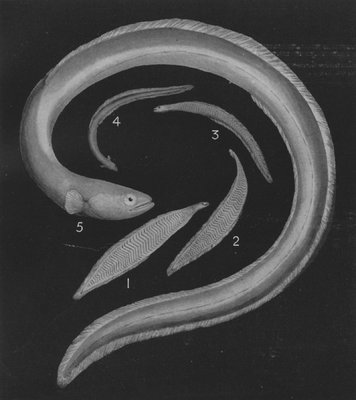
Photo: Gambier Bolton.
CASSOWARY
Its bare head is capped with a helmet. Unlike the plumage of most birds its feathers are loose and hair-like, whilst its wings are merely represented by a few black quills. It is flightless and entirely dependent on its short powerful legs to carry it out of danger.

Photo: Gambier Bolton.
THE KIWI, ANOTHER FLIGHTLESS BIRD, OF REMARKABLE APPEARANCE, HABITS, AND STRUCTURE
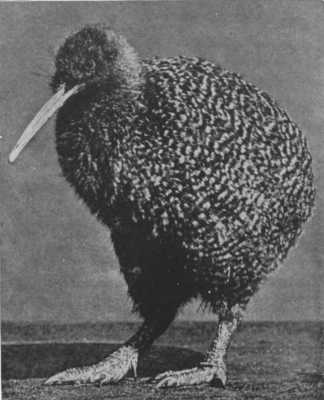
The herring-gull is by nature a fish-eater; but of recent years, in some parts of Britain, it has been becoming in the summer months more and more of a vegetarian, scooping out the turnips, devouring potatoes, settling on the sheaves in the harvest field and gorging itself with grain. Similar experiments, usually less striking, are known in many birds; but the most signal illustration is that of the kea or Nestor parrot of New Zealand, which has taken to lighting on the loins of the sheep, tearing away the fleece, cutting at the skin, and gouging out fat. Now the parrot belongs to a vegetarian or frugivorous stock, and this change of diet in the relatively short time since sheep-ranches were established in New Zealand is very striking. Here, since we know the dates, we may speak of evolution going on under our eyes. It must be remembered that variations in habit may give an[Pg 202] animal a new opportunity to test variations in structure which arise mysteriously from within, as expressions of germinal changefulness rather than as imprints from without. For of the transmissibility of the latter there is little secure evidence.
Experiments in Locomotion
It is very interesting to think of the numerous types of locomotion which animals have discovered—pulling and punting, sculling and rowing, and of the changes that are rung on these four main methods. How striking is the case of the frilled lizard (Chlamydosaurus) of Australia, which at the present time is, as it were, experimenting in bipedal progression—always a rather eventful thing to do. It gets up on its hind-legs and runs totteringly for a few feet, just like a baby learning to walk.
How beautiful is the adventure which has led our dipper or water-ouzel—a bird allied to the wrens—to try walking and flying under water! How admirable is the volplaning of numerous parachutists—"flying fish," "flying frog," "flying dragon," "flying phalanger," "flying squirrel," and more besides, which take great leaps through the air. For are these not the splendid failures that might have succeeded in starting new modes of flight?
Most daring of all, perhaps, are the aerial journeys undertaken by many small spiders. On a breezy morning, especially in the autumn, they mount on gate-posts and palings and herbage, and, standing with their head to the wind, pay out three or four long threads of silk. When the wind tugs at these threads, the spinners let go, and are borne, usually back downwards, on the wings of the wind from one parish to another. It is said that if the wind falls they can unfurl more sail, or furl if it rises. In any case, these wingless creatures make aerial journeys. When tens of thousands of the used threads sink to earth, there is a "shower of gossamer." On his Beagle voyage Darwin observed that vast numbers of small gossamer spiders were borne on to the ship when it was sixty miles distant from the land.
THE AUSTRALIAN FRILLED LIZARD, WHICH IS AT PRESENT TRYING TO BECOME A BIPED
When it gets up on its hind-legs and runs for a short distance it folds its big collar round its neck.
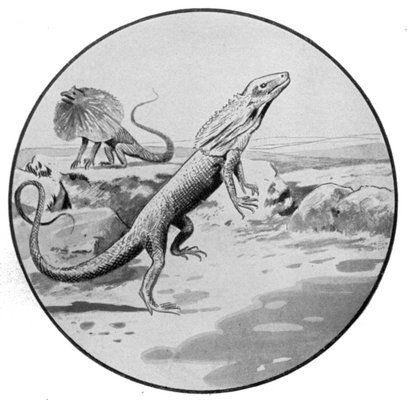
A CARPET OF GOSSAMER
The silken threads used by thousands of gossamer spiders in their migrations are here seen entangled in the grass, forming what is called a shower of gossamer. At the edge of the grass the gossamer forms a curtain, floating out and looking extraordinarily like waves breaking on a seashore.
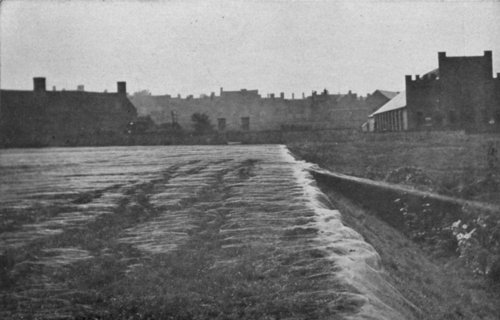
THE WATER-SPIDER
The spider is seen just leaving its diving-bell to ascend to the surface to capture air.
The spider jerks its body and legs out at the surface and then dives—
—carrying with it what looks like a silvery air-bubble—air entangled in the hair.
The spider reaches its air-dome. Note how the touch of its legs indents the inflated balloon.
Running down the side of the nest, the spider
—brushes off the air at the entrance, and the bubble ascends into the silken balloon.
Photos: J. J. Ward, F.E.S.
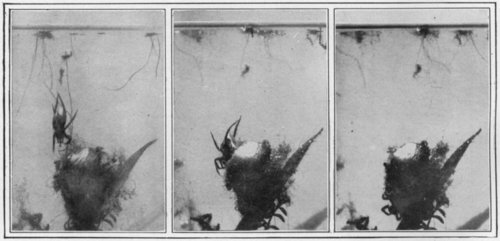
[Pg 203]
New Devices
It is impossible, we must admit, to fix dates, except in a few cases, relatively recent; but there is a smack of modernity in some striking devices which we can observe in operation to-day. Thus no one will dispute the statement that spiders are thoroughly terrestrial animals breathing dry air, but we have the fact of the water-spider conquering the under-water world. There are a few spiders about the seashore, and a few that can survive douching with freshwater, but the particular case of the true water-spider, Argyroneta natans, stands by itself because the creature, as regards the female at least, has conquered the sub-aquatic environment. A flattish web is woven, somehow, underneath the water, and pegged down by threads of silk. Along a special vertical line the mother spider ascends to the surface and descends again, having entangled air in the hairs of her body. She brushes off this air underneath her web, which is thereby buoyed up into a sort of dome. She does this over and over again, never getting wet all the time, until the domed web has become like a diving-bell, full of dry air. In this eloquent anticipation of man's rational device, this creature—far from being endowed with reason—lays her eggs and looks after her young. The general significance of the facts is that when competition is keen, a new area of exploitation is a promised land. Thus spiders have spread over all the earth except the polar areas. But here is a spider with some spirit of adventure, which has endeavoured, instead of trekking, to find a new corner near at home. It has tackled a problem surely difficult for a terrestrial animal, the problem of living in great part under water, and it has solved it in a manner at once effective and beautiful.
In Conclusion
We have given but a few representative illustrations of a great theme. When we consider the changefulness of living creatures, the transformations of cultivated plants and domesticated[Pg 204] animals, the gradual alterations in the fauna of a country, the search after new haunts, the forming of new habits, and the discovery of many inventions, are we not convinced that Evolution is going on? And why should it stop?[Pg 205]
[Pg 206]
[Pg 207]
